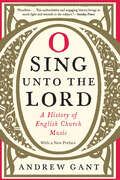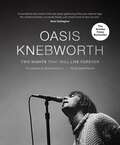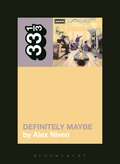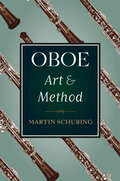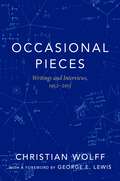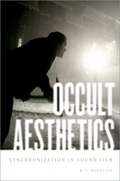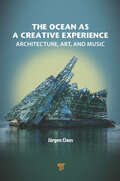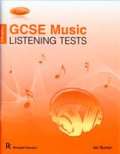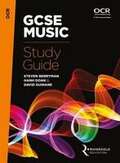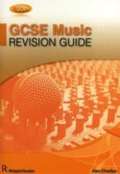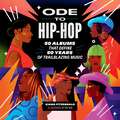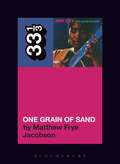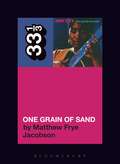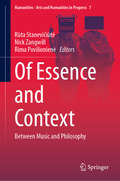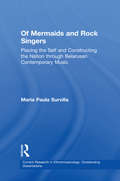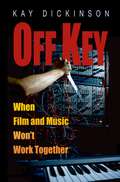- Table View
- List View
O Sing unto the Lord: A History of English Church Music
by Andrew GantFor as long as people have worshipped together, music has played a key role in church life. With O Sing unto the Lord, Andrew Gant offers a fascinating history of English church music, from the Latin chant of late antiquity to the great proliferation of styles seen in contemporary repertoires. The ornate complexity of pre-Reformation Catholic liturgies revealed the exclusive nature of this form of worship. By contrast, simple English psalms, set to well-known folk songs, summed up the aims of the Reformation with its music for everyone. The Enlightenment brought hymns, the Methodists and Victorians a new delight in the beauty and emotion of worship. Today, church music mirrors our multifaceted worldview, embracing the sounds of pop and jazz along with the more traditional music of choir and organ. And reflecting its truly global reach, the influence of English church music can be found in everything from masses sung in Korean to American Sacred Harp singing. From medieval chorales to “Amazing Grace,” West Gallery music to Christmas carols, English church music has broken through the boundaries of time, place, and denomination to remain familiar and cherished everywhere. Expansive and sure to appeal to all music lovers, O Sing unto the Lord is the biography of a tradition, a book about people, and a celebration of one of the most important sides to our cultural heritage.
O Sing unto the Lord: A History of English Church Music
by Andrew GantFor as long as people have worshipped together, music has played a key role in church life. With O Sing unto the Lord, Andrew Gant offers a fascinating history of English church music, from the Latin chant of late antiquity to the great proliferation of styles seen in contemporary repertoires. The ornate complexity of pre-Reformation Catholic liturgies revealed the exclusive nature of this form of worship. By contrast, simple English psalms, set to well-known folk songs, summed up the aims of the Reformation with its music for everyone. The Enlightenment brought hymns, the Methodists and Victorians a new delight in the beauty and emotion of worship. Today, church music mirrors our multifaceted worldview, embracing the sounds of pop and jazz along with the more traditional music of choir and organ. And reflecting its truly global reach, the influence of English church music can be found in everything from masses sung in Korean to American Sacred Harp singing. From medieval chorales to “Amazing Grace,” West Gallery music to Christmas carols, English church music has broken through the boundaries of time, place, and denomination to remain familiar and cherished everywhere. Expansive and sure to appeal to all music lovers, O Sing unto the Lord is the biography of a tradition, a book about people, and a celebration of one of the most important sides to our cultural heritage.
Oasis: THE SUNDAY TIMES BESTSELLER Two Nights That Will Live Forever
by Daniel Rachel Jill Furmanovsky***'A wonderful document of the last great gathering of the pre-internet age. No camera phones, no social media, just a band and its fans as one' -NOEL GALLAGHER On 10th and 11th August 1996, Oasis played the concerts that would define them, a band at the height of their powers playing to over 250,000 people.Twenty-five years on, this is the inside story of those nights, told through the breathtaking photographs of Jill Furmanovsky, granted unprecedented access to Oasis throughout that summer. Also includes newly obtained first-hand accounts from the people who were there - including Noel Gallagher and Alan McGee - in text by award-winning author Daniel Rachel. From relaxed rehearsals and warm-up concerts to Knebworth itself - backstage, onstage, flying high above the site - many of the stunning photographs in this book have never been seen anywhere before.This the definitive account of two nights that a generation will never forget.
Oasis' Definitely Maybe (33 1/3)
by Alex NivenOasis's incendiary 1994 debut album Definitely Maybe managed to summarize almost the entire history of post-fifties guitar music from Chuck Berry to My Bloody Valentine in a way that seemed effortless. But this remarkable album was also a social document that came closer to narrating the collective hopes and dreams of a people than any other record of the last quarter century. In a Britain that had just undergone the most damaging period of social upheaval in a century under the Thatcher government, Noel Gallagher ventriloquized slogans of burning communitarian optimism through the mouth of his brother Liam and the playing of the other Oasis 'everymen': Paul McGuigan, Paul Arthurs and Tony McCarroll. On Definitely Maybe, Oasis communicated a timeworn message of idealism and hope against the odds, but one that had special resonance in a society where the widening gap between high and low demanded a newly superhuman kind of leaping. Alex Niven charts the astonishing rise of Oasis in the mid 1990s and celebrates the life-affirming, communal force of songs such as "Live Forever,†? "Supersonic,†? and "Cigarettes & Alcohol.†? In doing so, he seeks to reposition Oasis in relation to their Britpop peers and explore one of the most controversial pop-cultural narratives of the last thirty years.
Oasis' Definitely Maybe (33 1/3)
by Alex NivenOasis's incendiary 1994 debut album Definitely Maybe managed to summarize almost the entire history of post-fifties guitar music from Chuck Berry to My Bloody Valentine in a way that seemed effortless. But this remarkable album was also a social document that came closer to narrating the collective hopes and dreams of a people than any other record of the last quarter century. In a Britain that had just undergone the most damaging period of social upheaval in a century under the Thatcher government, Noel Gallagher ventriloquized slogans of burning communitarian optimism through the mouth of his brother Liam and the playing of the other Oasis 'everymen': Paul McGuigan, Paul Arthurs and Tony McCarroll. On Definitely Maybe, Oasis communicated a timeworn message of idealism and hope against the odds, but one that had special resonance in a society where the widening gap between high and low demanded a newly superhuman kind of leaping. Alex Niven charts the astonishing rise of Oasis in the mid 1990s and celebrates the life-affirming, communal force of songs such as “Live Forever,” “Supersonic,” and “Cigarettes & Alcohol.” In doing so, he seeks to reposition Oasis in relation to their Britpop peers and explore one of the most controversial pop-cultural narratives of the last thirty years.
Oboe Art and Method
by Martin SchuringIn Oboe Art and Method, veteran oboe performer and instructor Martin Schuring describes in detail all of the basic techniques of oboe playing and reed making, with expert tips and step-by-step instructions for how best to perform each of these tasks with grace and technical efficiency. Schuring's straightforward and articulate explanations of breathing, embouchure, finger technique, articulation, phrasing, and more help demystify the earliest stages of oboe playing and beyond. In addition, Schuring provides excellent advice on the "extra-musical"; practicing, instrument care and adjustment, professional development, and career development-related issues. The oboe is a notoriously complicated instrument, and this book aims to remove as much of the complexity as possible, to present techniques that work, and to discuss these in a clear-cut manner. Students who start with this book will learn with confidence that these methods will steer them straight down an effective path. A concise and eminently useful guide, Oboe Art and Method is a must-have for all who perform, teach, or are learning to play the oboe, in both conservatories and private instruction.
Occasional Pieces: Writings and Interviews, 1952-2013
by Christian WolffAs one of the original pioneering composers of the American experimental music movement and a well known scholar of classics, Christian Wolff has long been active as a significant thinker and elegant writer on music. With Occasional Pieces, Wolff brings together a collection of his most notable writings and interviews from 1950 to the present, shining a new light on American music of the second half of the twentieth century. The collection opens with some of his earliest writings on his craft, discussing his own proto-minimalist compositional procedures and the music and ideas that led him to develop these techniques. Organized chronologically to give a sense of the development of Wolff's thinking on music over the course of his career, some of the pieces delve into connections of music-making to social and political issues, and the concept of indeterminacy as it applies to performance, while others offer insights into the work of Wolff's notable contemporaries including John Cage, Morton Feldman, Earle Brown, David Tudor, Frederic Rzewski, Cornelius Cardew , Dieter Schnebel, Pauline Oliveros, and Merce Cunningham. An invaluable resource for historians, composers, listeners and students alike, Occasional Pieces offers a deep dive into Christian Wolff's musical world and brings new light to the history of the American experimental movement.
OCCASIONAL PIECES C: Writings and Interviews, 1952-2013
by Christian WolffAs one of the original pioneering composers of the American experimental music movement and a well known scholar of classics, Christian Wolff has long been active as a significant thinker and elegant writer on music. With Occasional Pieces, Wolff brings together a collection of his most notable writings and interviews from 1950 to the present, shining a new light on American music of the second half of the twentieth century. The collection opens with some of his earliest writings on his craft, discussing his own proto-minimalist compositional procedures and the music and ideas that led him to develop these techniques. Organized chronologically to give a sense of the development of Wolff's thinking on music over the course of his career, some of the pieces delve into connections of music-making to social and political issues, and the concept of indeterminacy as it applies to performance, while others offer insights into the work of Wolff's notable contemporaries including John Cage, Morton Feldman, Earle Brown, David Tudor, Frederic Rzewski, Cornelius Cardew , Dieter Schnebel, Pauline Oliveros, and Merce Cunningham. An invaluable resource for historians, composers, listeners and students alike, Occasional Pieces offers a deep dive into Christian Wolff's musical world and brings new light to the history of the American experimental movement.
Occult Aesthetics: Synchronization in Sound Film (Oxford Music / Media)
by K.J. DonnellyIn this groundbreaking book, acclaimed film music author Kevin Donnelly offers the first sustained theorization of synchronization in sound film. Donnelly addresses the manner in which the lock of the audio and the visual exerts a perceptible synergy, an aesthetic he dubs occult: a secret and esoteric effect that can dissipate in the face of an awareness of its existence. Drawing upon theories of sound from Sergei Eisenstein to Pierre Schaeffer to Michel Chion, the book investigates points of synchronization as something like repose, providing moments of comfort in a potentially threatening environment that can be fraught with sound and image stimuli. Correspondingly, lack of synchrony between sound and images is characterized as potentially disturbing for the viewer, a discomfort that signals moments of danger. From this perspective, the interplay between the two becomes the central dynamic of audio-visual culture more generally, which, as Donnelly argues, provides a starting point for a new understanding of audio/visual interactions. This fresh approach to the topic is discussed in theoretical and historical terms as well as elaborated through analysis of and reference to a broad selection of films and their soundtracks including, among others, Singin' in the Rain, Saw, Shanghai Express, and Assault on Precinct 13.
The Ocean as a Creative Experience: Architecture, Art, and Music
by Juergen ClausThis book by artist, diver, and editor-in-chief of an underwater magazine Jürgen Claus is a milestone among the books dedicated to the planet sea. It is a knowledge-rich overview, created from facts and experiences, of three main themes that have never been described in context. Marine architectures from both the Pacific and Atlantic regions have now moved from vision to reality. Whether it is a sail-shaped architecture in Nouméa or a whale-shaped one in the Arctic region. Special attention is paid by Prof. Claus to post-disaster architecture. The book will encourage young readers to design metabolic buildings themselves. That the seascape has also become a fluid studio for visual artists may come as a surprise. The works of art, some of which the author has experienced first-hand, have intertwined with an ecological, sustainable way of working. And this is also true to a special degree for the sound artists. They realize their sonic worlds with recordings from the sounding world underwater, a concert hall of hitherto unknown dimensions. The author’s experience as a professor of media art with students flows into the description of multimedia or media-related ocean installations. Here the book becomes a stimulus for realizing one’s own experiences.
The Ocean as a Creative Experience: Architecture, Art, and Music
by Juergen ClausThis book by artist, diver, and editor-in-chief of an underwater magazine Jürgen Claus is a milestone among the books dedicated to the planet sea. It is a knowledge-rich overview, created from facts and experiences, of three main themes that have never been described in context. Marine architectures from both the Pacific and Atlantic regions have now moved from vision to reality. Whether it is a sail-shaped architecture in Nouméa or a whale-shaped one in the Arctic region. Special attention is paid by Prof. Claus to post-disaster architecture. The book will encourage young readers to design metabolic buildings themselves. That the seascape has also become a fluid studio for visual artists may come as a surprise. The works of art, some of which the author has experienced first-hand, have intertwined with an ecological, sustainable way of working. And this is also true to a special degree for the sound artists. They realize their sonic worlds with recordings from the sounding world underwater, a concert hall of hitherto unknown dimensions. The author’s experience as a professor of media art with students flows into the description of multimedia or media-related ocean installations. Here the book becomes a stimulus for realizing one’s own experiences.
OCR GCSE Music Listening Tests (PDF)
by Barbara Ashby Margie MarshallWritten by experienced teachers, these tests will help to prepare you fully for the Listening and Appraising component of your GCSE course. This book contains: • Three sample Listening and Appraising papers • Guidance on how to prepare for the exam • Answers to all of the questions so that you can check your work • A glossary of technical terms • Downloadable audio for all the questions
OCR GCSE Music Listening Tests (PDF)
by Ian BurtonThis book contains a series of questions that will help you to prepare fully for Unit 4 (Listening Test) of your GCSE exam. It has been carefully written by an experienced teacher and examiner to match the requirements of the new OCR GCSE Music specification (for first teaching in 2009 and first exam in 2011). Contents include: Shared music Dance music Descriptive music
OCR GCSE Music (PDF)
by Steven Berryman Hanh Doan David GuinaneThe OCR GCSE Music Study Guide is a definitive study guide for the 'reformed' GCSE (9-1) specification. Written by experts, this comprehensive guide: <ul<li>Covers all components of the GCSE: performing, composing and appraising. Gives support and practice in dealing with 'unfamiliar' repertoire. Offers comprehensive support for the composing briefs. Provides tests and activities to help monitor progress. Supplies practice questions and advice on essay writing. Introduces the terminology and techniques that the specification requires students to know.
OCR GCSE Music Revision Guide (PDF)
by Alan CharltonThis revision guide presents all of the key information that you will need to know for your written exam. It includes a revision section on the elements of music, the most important facts about all of the topics in Areas of Study 2, 3 and 4, and test yourself questions that will allow you to check your knowledge. Areas of study include: Classical Romantic Pop Ballads Jazz Indian Classical Gamelan Choral classics African a cappella Baroque and Chamber music Waltz Tango Salsa Disco American line dance Irish Jig and Reel Bhangra Programme and Film music nbsp;
OCR GCSE Music. Revision Guide (PDF)
by Alan CharltonThis revision guide presents all of the key information that you will need to know for your written exam. It includes a revision section on the elements of music, the most important facts about all of the topics in Areas of Study 2, 3 and 4, and test yourself questions that will allow you to check your knowledge.
OCR GCSE Music Study Guide
by Steven Berryman Hanh Doan David GuinaneA definitive study guide for the 'reformed' GCSE (9-1) specification. Written by experts, this comprehensive guide: • covers all components of the GCSE: Performing, Composing and Appraising • gives support and practice in dealing with ‘unfamiliar’ repertoire • offers comprehensive support for the composing briefs • provides tests and activities to help monitor progress • supplied practice questions and advice on essay writing • introduces the terminology and techniques that the specification requir...
OCR GCSE Music Study Guide (PDF)
by Steven Berryman Hanh Doan David GuinaneThe OCR GCSE Music Study Guide is a definitive study guide for the 'reformed' GCSE (9-1) specification. Written by experts, this comprehensive guide: Covers all components of the GCSE: performing, composing and appraising. Gives support and practice in dealing with 'unfamiliar' repertoire. Offers comprehensive support for the composing briefs. Provides tests and activities to help monitor progress. Supplies practice questions and advice on essay writing. Introduces the terminology and techniques that the specification requires students to know.
Ode to Hip-Hop: 50 Albums That Define 50 Years of Trailblazing Music
by Kiana FitzgeraldCelebrate the music that has shaped the culture and given us some of the greatest hits of all time with this vibrantly illustrated anthology, featuring 50 of the most lauded, controversial, and iconic hip-hop albums! From underground roots to mainstream popularity, hip-hop's influence on music and entertainment around the world has been nothing short of extraordinary. Ode to Hip-Hop chronicles the journey with profiles of fifty albums that have defined, expanded, and ultimately transformed the genre into what it is today. From 2 Live Crew's groundbreaking As Nasty As They Wanna Be in 1989 to Cardi B's similarly provocative Invasion of Privacy almost thirty years later, and more, Ode to Hip-Hop covers hip-hop from coast to coast. Organized by decade and with sidebars on fashion, mixtapes, and key players throughout, the result is a comprehensive homage to hip-hop, published just in time for the fiftieth anniversary. Enjoyed in the club, at a party, through speakers or headphones--the albums in this book deserve to be listened to again and again, for the next fifty years and beyond. Albums featured: Kurtis Blow (self-titled, 1980); The Message (Grandmaster Flash and the Furious Five, 1982); Run-D.M.C (self-titled, 1984), Hot, Cool & Vicious (Salt-N-Pepa, 1986); Paid in Full (Eric B. & Rakim, 1987); Straight Outta Compton (N.W.A, 1988); Lyte as a Rock (MC Lyte, 1988); As Nasty as They Wanna Be (2 Live Crew, 1989); Mama Said Knock You Out (LL Cool J, 1990); People's Instinctive Travels and the Paths of Rhythm (A Tribe Called Quest, 1990); The Chronic (Dr. Dre, 1992); Enter the Wu-Tang (36 Chambers) (Wu-Tang Clan, 1993); Black Reign (Queen Latifah, 1993); Doggystyle (Snoop Dogg, 1993); Illmatic (Nas, 1994); Ready to Die (The Notorious B.I.G., 1994); The Diary (Scarface, 1994); Funkdafied (Da Brat, 1994); Mystic Stylez (Three 6 Mafia, 1995); Hard Core (Lil' Kim, 1996); Ridin' Dirty (UGK, 1996); All Eyez On Me (2Pac, 1996); Supa Dupa Fly (Missy Elliott, 1997); Aquemini (Outkast, 1998); The Miseducation of Lauryn Hill (Lauryn Hill, 1998); It's Dark and Hell Is Hot (DMX, 1998); Things Fall Apart (The Roots, 1999); Da Baddest B***h (Trina, 2000); The Marshall Mathers LP (Eminem, 2000); The Blueprint (JAY-Z, 2001); Lord Willin' (Clipse, 2002); Get Rich or Die Tryin' (50 Cent, 2003); The College Dropout (Kanye West, 2004); Let's Get It: Thug Motivation 101 (Young Jeezy, 2005); King (T.I., 2006); Lupe Fiasco's the Cool (Lupe Fiasco, 2007); The Carter III (Lil Wayne, 2008); The State vs. Radric Davis (Gucci Mane, 2009); Pink Friday (Nicki Minaj, 2010); Watch the Throne (JAY-Z & Kanye West, 2011); Nothing Was the Same (Drake, 2013); To Pimp a Butterfly (Kendrick Lamar, 2015); DS2 (Future, 2015); Culture (Migos, 2017); Invasion of Privacy (Cardi B., 2018); Whack World (Tierra Whack, 2018); Eve (Rapsody, 2019); City on Lock (City Girls, 2020); Montero (Lil Nas X, 2021); Traumazine (Megan Thee Stallion, 2022)
Odetta’s One Grain of Sand (33 1/3)
by Matthew Frye JacobsonWhen 20-year-old Odetta Holmes-classically trained as a vocalist and poised to become “the next Marian Anderson”-veered away from both opera and musical theater in favor of performing politically charged field hollers, prison songs, work songs, and folk tunes before mixed-race audiences in 1950s coffee houses, she was making one of the most portentous decisions in the history of both American music and Civil Rights.Released the same year as her famous rendition of “I'm on My Way” at the March on Washington, One Grain of Sand captures the social justice project that was Odetta's voice. “There was no way I could say the things I was thinking, but I could sing them,” she later remarked. In pieces like “Moses, Moses,” “Ain't No Grave,” and “Ramblin' Round Your City,” One Grain of Sand embodies Odetta's approach to the folk repertoire as both an archive of black history and a vehicle for radical expression. For many among her audience, a song like “Cotton Fields” represented a first introduction to black history at a time when there was as yet no academic discipline going by this name, and when history books themselves still peddled convenient fictions of a fundamentally “happy” plantation past. And for many among her audience, black and white, this young woman's pride in black artistry and resolve, and her open rage and her challenge to whites to recognize who they were and who they had been, too, modeled the very honesty and courage that the movement now called for.
Odetta’s One Grain of Sand (33 1/3 #136)
by Matthew Frye JacobsonWhen 20-year-old Odetta Holmes-classically trained as a vocalist and poised to become “the next Marian Anderson”-veered away from both opera and musical theater in favor of performing politically charged field hollers, prison songs, work songs, and folk tunes before mixed-race audiences in 1950s coffee houses, she was making one of the most portentous decisions in the history of both American music and Civil Rights.Released the same year as her famous rendition of “I'm on My Way” at the March on Washington, One Grain of Sand captures the social justice project that was Odetta's voice. “There was no way I could say the things I was thinking, but I could sing them,” she later remarked. In pieces like “Moses, Moses,” “Ain't No Grave,” and “Ramblin' Round Your City,” One Grain of Sand embodies Odetta's approach to the folk repertoire as both an archive of black history and a vehicle for radical expression. For many among her audience, a song like “Cotton Fields” represented a first introduction to black history at a time when there was as yet no academic discipline going by this name, and when history books themselves still peddled convenient fictions of a fundamentally “happy” plantation past. And for many among her audience, black and white, this young woman's pride in black artistry and resolve, and her open rage and her challenge to whites to recognize who they were and who they had been, too, modeled the very honesty and courage that the movement now called for.
Of Essence and Context: Between Music and Philosophy (Numanities - Arts and Humanities in Progress #7)
by Rima Povilionienė Rūta Stanevičiūtė Nick ZangwillThis book provides a new approach to the intersections between music and philosophy. It features articles that rethink the concepts of musical work and performance from ontological and epistemological perspectives and discuss issues of performing practices that involve the performer’s and listener’s perceptions. In philosophy, the notion of essence has enjoyed a renaissance. However, in the humanities in general, it is still viewed with suspicion. This collection examines the ideas of essence and context as they apply to music. A common concern when thinking of music in terms of essence is the plurality of music. There is also the worry that thinking in terms of essence might be an overly conservative way of imposing fixity on something that evolves. Some contend that we must take into account the varying historical and cultural contexts of music, and that the idea of an essence of music is therefore a fantasy. This book puts forward an innovative approach that effectively addresses these concerns. It shows that it is, in fact, possible to find commonalities among the many kinds of music. The coverage combines philosophical and musicological approaches with bioethics, biology, linguistics, communication theory, phenomenology, and cognitive science. The respective chapters, written by leading musicologists and philosophers, reconsider the fundamental essentialist and contextualist approaches to music creation and experience in light of twenty-first century paradigm shifts in music philosophy.
Of Mermaids and Rock Singers: Placing the Self and Constructing the Nation THrough Belarusan Contemporary Music
by Maria Paula SurvillaThis book examines the roles, functions, and interpretations of rock music as part of the initial push towards exploring national and personal identities in a newly independent Belarus. It also includes a summary of rock concert activity in Belarus.
Of Mermaids and Rock Singers: Placing the Self and Constructing the Nation THrough Belarusan Contemporary Music
by Maria Paula SurvillaThis book examines the roles, functions, and interpretations of rock music as part of the initial push towards exploring national and personal identities in a newly independent Belarus. It also includes a summary of rock concert activity in Belarus.
Off Key: When Film and Music Won't Work Together
by Kay DickinsonIn Off Key, Kay Dickinson offers a compelling study of how certain alliances of music and film are judged aesthetic failures. Based on a fascinating and wide-ranging body of film-music mismatches, and using contemporary reviews and histories of the turn to post-industrialization, the book expands the ways in which the union of the film and music businesses can be understood. Moving beyond the typical understanding of film music that privileges the score, Off Key also incorporates analyses of rock 'n' roll movies, composer biopics, and pop singers crossing over into acting. By doing this, it provides a fuller picture of how two successful entertainment sectors have sought out synergistic strategies, ones whose alleged "failures" have much to tell about the labor practices of the creative industries, as well as our own relationship to them and to work itself. A provocative and politically-conscious look at music-image relations, Off Key will appeal to students and scholars of film music, cinema studies, media studies, cultural studies, and labor history.
